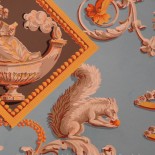New Online Resource

We’re pleased to announce the availability of a new online resource: The Atlas of the Rhode Island Book Trade in the Eighteenth Century. The Atlas integrates a timeline and a map in an attempt to pinpoint as many participants in the book trade (from printers and booksellers to book binders and rag collectors) as possible in space and time. Dragging the timeline left or right (or scrolling a mouse wheel or double clicking at a point in time) adjusts the map view to show only members of the trade in operation at that point in time. The Atlas also features a searchable or browseable database and a number of viewing options, including the option to view the atlas overlaid with eighteenth-century maps of Newport and Providence.
Geographic visualization of all kinds of information abounds on the internet*, but what kind of questions does this resource answer? First, it’s a great way to get a sense of the spread and development of the book trade in the state over the course of the century. Here’s a rough dramatization of the process in twenty seconds of video:
Just considering previous posts from this blog, the Atlas offers a number of insights. In our most recent post, it identified the fact that Old Bet’s exhibition was actually taking place in the location used by the printer of the broadside. We can use the Atlas to chart the progress of Thomas Truman’s exciting late-night experimentations with glowing water. We mentioned the sign of the bunch of grapes when it marked the location of Gladding’s department store, but you can also use the Atlas to find two earlier uses of the sign. And the broadside advertising the visit of a robot to Providence in 1796 gives “Mr. Todd’s bookstore” as one of the locations for ticket sales. Where was Todd’s bookstore at that time? That’s a perfect question for the Atlas.
* For instance, find out what people think the boundaries of Providence neighborhoods are, based on their Flickr tags at http://boundaries.tomtaylor.co.uk/#2477058 .

